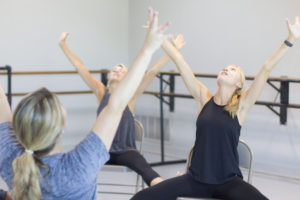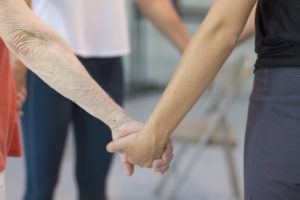Dance for Parkinson’s program explores movements
PRINCETON, N.J. – With physical activity, the brain and the body function better, and so recently a

— Provided photo
dance teacher has been helping special students with their moves.
When Rachel Stanislawczyk interned and became a lead dance teacher for the Mark Morris Dance Group’s Dance for Parkinson’s Program in Brooklyn, N.Y., she decided to broaden the horizons of that program.
On returning to New Jersey, Stanislawczyk proposed the idea of starting a Dance for Parkinson’s program to the Princeton Ballet School, “knowing that their mission and dedication to live accompaniment aligned perfectly with her vision of the program,” says Lindsay Cahill, assistant teacher at Princeton Ballet School.
The Parkinson’s students will need help with controlling their movements, because Parkinson’s disease is a neurological disorder of the central nervous system that affects movement, and often includes tremors.
Therefore, Stanislawczyk is offering the eight-week Dance for Parkinson’s classes that will be running through March 28, this year in Princeton, and she is the lead dance teacher.
Together with her assistant, the dance teachers create “a warm sanctuary for movement exploration, and a social atmosphere to support artistic venture,” Cahill says.
Affiliated with the American Repertory Ballet (ARB), the Princeton Ballet School Dance for Parkinson’s program have live musical accompanied by one of ARB’s staff of professional musicians, Cahill says.
“Each class is infused with guided imagery, vocalization, and movement from several different genres of dance, to provide participants with holistic and dynamic experiences,” Cahill explains.
She says the Dance for Parkinson’s teachers and volunteers encourage participants to “’think like a dancer;’ to indulge in creativity, expression, and shared humanistic experiences.”

— Provided photo
This inclusive program is open to all levels of ability. The participants include senior adults, their care partners, family, friends, children and grandchildren, who may experience therapeutic relief from
dancing.
However, the classes are not considered therapy, but are solely for getting people together to move, share, and enjoy the elements of dance, says Cahill.
Nevertheless, the dance movements help the Parkinson’s students’ bodies to naturally produce the neurotransmitter, Dopamine, which is a feel-good chemical in the brain, and that helps with signaling body movements.
In order to offer a variety of dance movements, the dance instructors incorporate several different dance styles such as ballet, modern jazz, tap, and tango.
“The formula for each class differs as participants are led to explore different choreographic, improvisational, and compositional tools,” Cahill says.
And, the instructors also keep the classes interesting by sometimes revolving them around a central theme that includes aspects of song, poetry, games, and partner work.
They encourage the students to participate to the best of their own abilities while seated or standing during each class, Cahill says.
At the beginning of classes, the instructors remind students that there are no right or left sides, and no right or wrong ways of moving.
There are also volunteers to assist students during each of these one-hour-and-fifteen-minutes classes.
These classes are fairly new to Princeton Ballet School where the first sessions started in August 2018.
The teachers held the first two sessions of the program at their Princeton location. However, this year’s winter sessions are at their Cranbury studios. They also have a studio in New Brunswick.
The Cranbury and Princeton studios are wheelchair accessible. All locations feature state-of-the-art dance floors that are shock absorbent and slip proof.
